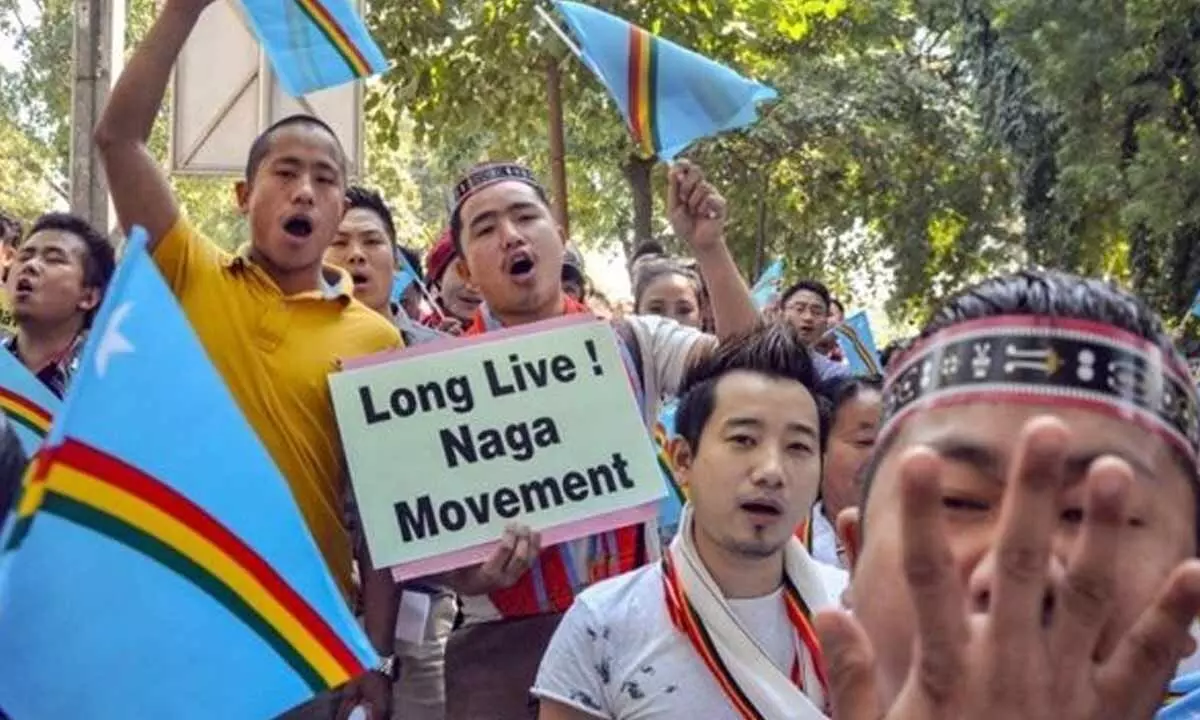Live
- Pawan Kalyan Pledges Action To Combat Pollution in Visakhapatnam
- Malaysia sees drops in marriages, divorces in 2023
- Siddaramaiah govt snatching away food security of poor, says ex-CM Bommai
- AAP releases first list of 11 candidates for Delhi Assembly elections
- District Collector Adarsh Surabhi wants disabled people to be inspired by the perseverance and hard work of the disabled
- Jupally, Seethakka inaugurate Third Island in Laknavaram Lake
- Chittoor police bust interstate robbery Gang
- Expedite Vizag-Chennai Industrial Corridor works says Collector S Venkateswar
- Chandrababu speaks on High Court Bench in Kurnool, says ready to develop state
- 3-day training to visually challenged students concludes
Just In
Nagaland Insurgency - A deep-rooted ethnic & political conflict


A deep-rooted ethnic & political conflict
There is a strong contention that Naga Hills (Nagaland) has never been part of India
Naga Insurgency has seen many milestones. Led by AZ Phizo, a fierce Naga leader, it began in 1947, has since seen many developments and layers. Half of the present-day Nagaland was called Tuensang Hill Naga Area which is the eastern part of Nagaland and was part of NEFA till 1963. The existence of the Naga tribes started the insurgency.
One of the long-running tales of insurgency and development in India is of the North Eastern Region of India and in Naga insurgency. The Naga political issue is ancient. Naga Hills became part of British India in 1881. Nagas rebelled against Simon Commission in 1929 and clearly revealed their resistance thus: “Leave us alone to determine for ourselves as in Ancient times.” Naga National Council (NNC) came into existence in 1946 and on 14 August 1947, Phizo declared Nagaland as an independent state.
Don’t be alarmed when you will come to know about the complexities of Nagaland. Within India, the demand of another independent nation is their demand. Before we understand the political formation of the state, let’s see the Naga stance and important events and concerns for a better understanding of the ethnic conflict of the Nagas with the government: (a) First and foremost, Naga Hills (present State of Nagaland) has never been part of India; (b) There was never a written agreement between Nagas and the British that surrenders the Naga sovereignty; (c) The civil and criminal administration has always been in the hands of Nagas only; (d) The Nagas rejected the idea of joining the Indian Union in 1929 and the same was communicated to the Simon Commission; (e) The Akbar Hydari Agreement of 1947 was valid for 10 years only, after which the Nagas could determine their own future; (f) Nagas declared their own independence on 14th August 1947, hence did not join the Union of India; (g) In January 1950, Nagas did not accept the new Constitution of India; hence it is not binding on them; (h) The Naga referendum of 1951 voted overwhelmingly (99%) in favor of an independent Nagaland; (j) In 1953, the Nagaland Constitution was framed and on 22 Mar 1956, the Federal Republic of Nagaland came into existence; (k) Naga nation encompasses areas in India and Myanmar (Greater Nagaland); (l) On 23rd January 1993, Naga nation has been accepted as a member by UNPO at Hague.
India’s Stance and Naga Akbar Hydari Agreement
India rejects all these contentions. The basis of the Naga Akbar Hydari Accord (Nine Point Agreement), from the Indian view point, was a clear acceptance of the Indian Constitution. The debatable Clause IX of the agreement affords the Nagas the option of selecting for them the exact administration set up within the Indian Constitution has been interpreted differently by the NNC and A Z Phizo which leads to continuous conflicts.
Why Naga insurgency still continues
In 1963, the Naga Hills was granted full Statehood based on a 16-point agreement with the government. The aspirations of the local population were never met by the power which was given to them. This resulted in conflicts and insurgency.
(a) Traditionally, Nagas have been a fiercely independent people and therefore, subjugating them to anybody other than their own tribal elders is totally alien to the Naga way of life and unacceptable to them.
(b) Fierce tribal loyalties and total mistrust of other Naga tribes and people from the plains precludes any settlement.
(c) Unfortunately, concerns of North East and Naga insurgency were never a main agenda at national level as it does not affect the fortune and destiny of the parties operating in Delhi. Politicians, police, and bureaucrats also lack accountability about the happenings in the state.
(d) Assistance from foreign sources, especially ISI of Pakistan, Bangladesh, and China, and NGOs such as UNPO, Naga Vigil, NISC, Naga Support Group (NSG), and Christian organisations in Western countries.
(e) The presence of insurgency serves both politicians and UG organizations. This same purpose builds a strong nexus between the two.
(f) Today, under the cover of insurgency, large-scale diversion of funds from government machinery to vested groups is a normal practice. To some people it has become a business.
(g) Local support is also one of the primary factors. All Nagas irrespective of their vocation, or tribal affiliations support one or the other insurgent group.
(k) Rampant corruption and fewer developmental-related projects and activities.
(l) Excessive amount of money in urban areas and its obtainability has drawn a large number of youths into this profession.
In spite of putting numerous arrangements and attempts, the government has still not addressed all challenges and the quest to have an independent arrangement has many gaps and challenges. As things are changing and with increased awareness, changing world order, and geopolitical interests, it is yet important to have a deeper understanding of conflicts before any new modern revolutionary Naga movement comes up.
(The author is an ex-Army Officer and avid Economist. She is associated with BRICS RESEARCH CONFERENCE 2.0)

© 2024 Hyderabad Media House Limited/The Hans India. All rights reserved. Powered by hocalwire.com






